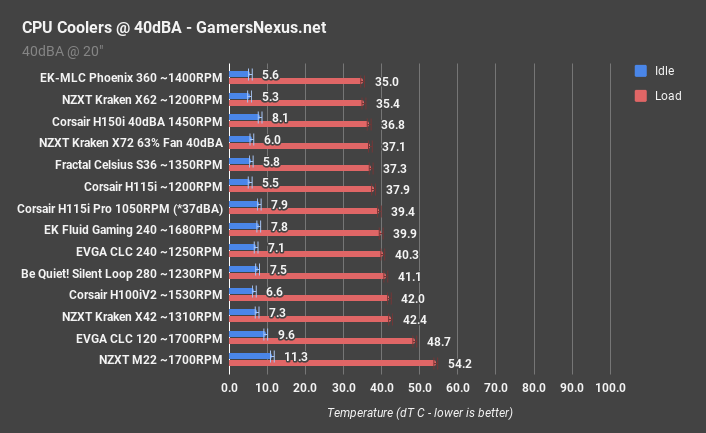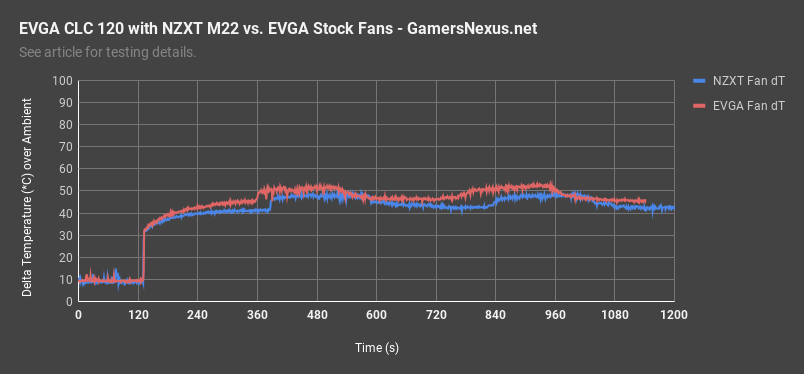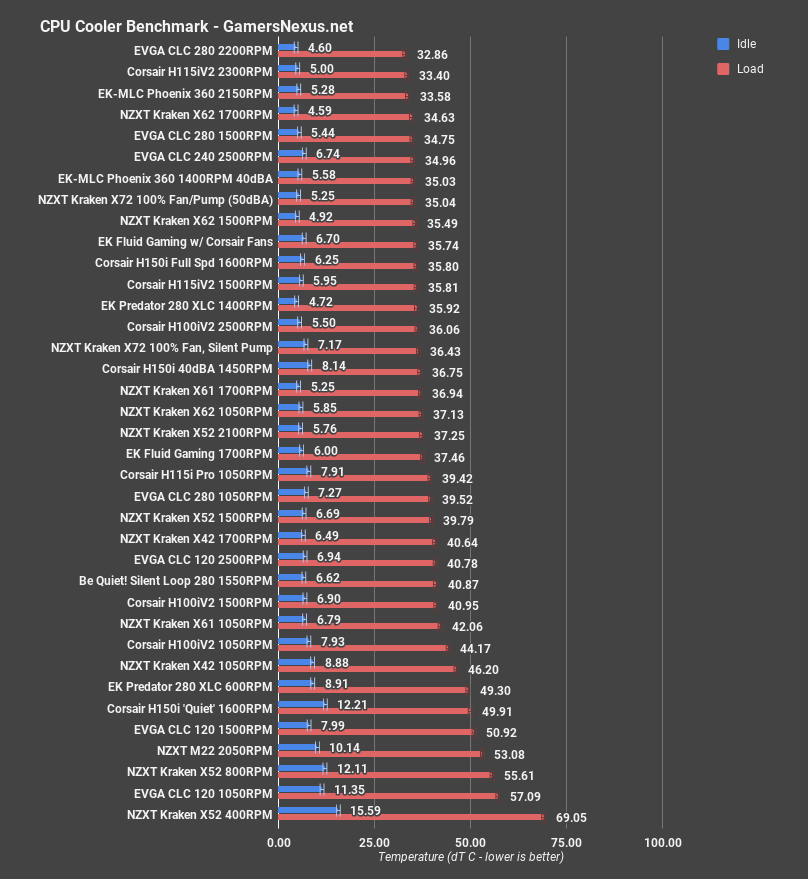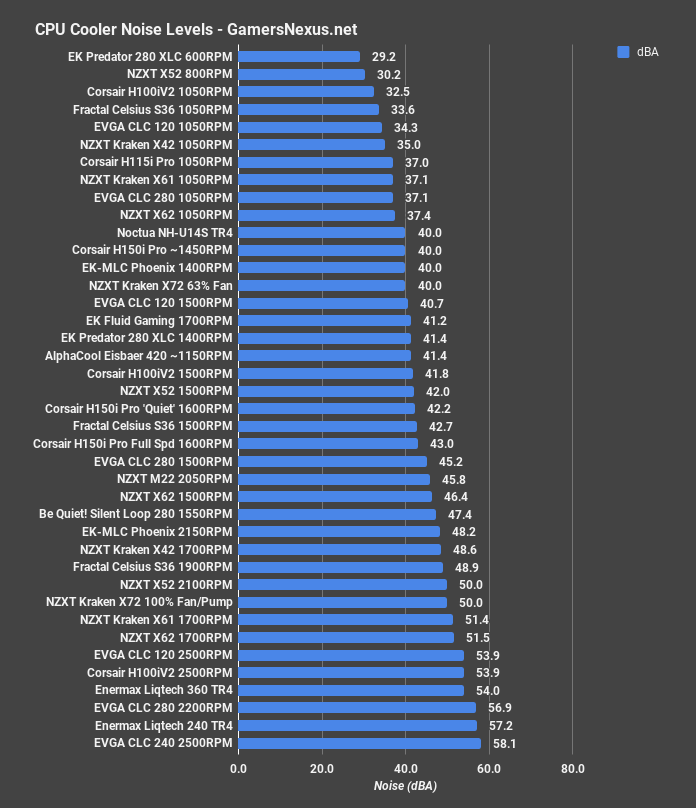The NZXT M22 is one of the stranger liquid coolers made by a relatively large liquid cooling manufacturer. NZXT dumped Asetek for this 120mm closed-loop cooler, instead opting for a pump-in-radiator design that circumvents Asetek patents and permits sale in the US. The M22 is a complement to NZXT’s Asetek products at the high-end, but comes in at $100 and 120mm. That’s a bit high for a 120mm liquid cooler, particularly considering that competition from EVGA’s CLC 120 comes in at $70 and is made by the familiar Asetek, but its performance may make up for the price differential. Today, we’ll find out.
Primary competition in this price class includes NZXT’s own Kraken X42, a 140mm Asetek-made design, and 240mm units from the same price class. NZXT’s M22 ships for $100 MSRP, and at that price, it’s competing (strictly in price) with the likes of the EVGA CLC 240, the Corsair H100i V2, and NZXT’s units. If we look strictly at size class, the EVGA CLC 120 competes most directly at $70. Despite its low price, that’s still a modern Asetek unit; it uses the same pump as any higher-end cooler, just has fewer fans. It’s not cheap garbage – it’s not something we recommend, either, but it’s not going to fall apart.
It’s a fierce market at $100. Even air coolers would reach equivalence or superior performance than NZXT’s M22. They’re going for one demographic, and one only: Has RGB LEDs and is exactly 120mm. That’s it. That’s the demo. If you’re not that, it’s really not worth the time or money to grab the M22.
To NZXT’s credit, the LED integration is the best-in-class for a 120mm liquid cooler. It’s also expensive, so that makes for an odd combination of size and price.
NZXT M22 Tear-Down
Our NZXT Kraken M22 tear-down revealed the design as unique in its ability to bypass Asetek’s patent, but flawed in its execution. Placing the pump centrally in the radiator does minimize the negative impact to airflow, as that’s (mostly) a dead-zone for the fan’s hub, but still has some bleed-over into critical areas of the fan blade. No air will get through that block, obviously, and it’s taking the place of heat-spreading fins. There’s a small, shallow 5-blade impeller inside of the pump housing and no fins in the central pump area. It’s just an impeller and a small electromagnet (motor), and that’s it. The microfins are still on the opposite side of the coldplate,
A lot of block space is wasted in this design. Flow is inefficiently routed and impeller design on the radiator eats critical cooling area. The M22 is made by Apaltek, not Asetek, and NZXT didn’t have much of an alternative to circumvent their partner’s (Asetek) patents with pump-on-block design.
CPU Cooler Test Methodology
CPU cooler testing is conducted using the bench defined below. We use a bench that is more carefully crafted for noise performance, opting for a passively cooled PSU and 23% RPM 980 Ti blower fan for very low system noise.
We strongly believe that our thermal testing methodology is among the best on this side of the tech-media industry. We've validated our testing methodology with thermal chambers and have proven near-perfect accuracy of results.
Conducting thermal tests requires careful measurement of temperatures in the surrounding environment. We control for ambient by constantly measuring temperatures with K-Type thermocouples and infrared readers. Two K-Type thermocouples are deployed around the test bench: One (T1) above the bench, out of airflow channels, and one (T2) approximately 2-3" in front of the cooler's intake fan. These two data points are averaged in a spreadsheet, creating a T3 value that is subtracted second-to-second from our AIDA64 logging of the CPU cores.
All six CPU cores are totaled and averaged second-to-second. The delta value is created by subtracting corresponding ambient readings (T3) from the average CPU core temperature. We then produce charts using a Delta T(emperature) over Ambient value. AIDA64 is used for logging thermals of silicon components, including the CPU and GPU diodes. We additionally log core utilization and frequencies to ensure all components are firing as expected. Voltage levels are measured in addition to fan speeds, frequencies, and thermals.
The cores are kept locked to 3.8GHz (x38 multiplier). VCore voltage is locked to 1.141v for the CPU. C-States are disabled, as is all other power saving. The frequency is locked without any interference from boost or throttle functions. This is to ensure that the CPU does not undergo any unexpected/uncontrollable power saving or boost states during testing, and ensures that the test platform remains identical from one device to the next.
Fan speeds are manually controlled unless otherwise defined. For liquid coolers, pumps are set to 100% speed unless otherwise defined.
No open bench fans are used for these CPU cooler tests. Only fans which are provided with the cooler are used.
| GN Test Bench 2015 | Name | Courtesy Of | Cost |
| Video Card | GTX 980 Ti Reference 23% RPM | NVIDIA | EOL |
| CPU | Intel i7-5930K CPU @ 3.8GHz | iBUYPOWER | $580 |
| Memory | Corsair Vengeance 32GB 2666MHz | Corsair | $175 |
| Motherboard | EVGA X99 Classified | GamersNexus | $365 |
| Power Supply | Enermax DigiFANLESS | Enermax | $250 |
| SSD | HyperX Savage SSD | Kingston Tech. | $130 |
| Case | Top Deck Tech Station | GamersNexus | $250 |
| CPU Cooler | This is what we're testing! | - | - |
We use an AMPROBE multi-diode thermocouple reader to log ambient actively. This ambient measurement is used to monitor fluctuations and is subtracted from absolute GPU diode readings to produce a delta value. For these tests, we configured the thermocouple reader's logging interval to 1s, matching the logging interval of GPU-Z and AIDA64. Data is calculated using a custom, in-house spreadsheet and software solution.
Our test starts with a 180s idle period to gauge non-gaming performance. A script automatically triggers the beginning of a CPU-intensive benchmark running Prime95 LFFTs. Because we use an in-house script, we are able to perfectly execute and align our tests between passes.
40dBA Noise Normalized Tests
Let’s start with the noise-normalized data, then we’ll get into flat-out testing with more liquid coolers on the chart.
Normalized at 40dBA across the board, the NZXT Kraken M22 falls in dead last, attributable in part to reduced surface area for heat spreading. The M22 operated at 54 degrees Celsius over ambient when restricted to 40dBA, markedly behind the EVGA CLC 120 – a cooler that we didn’t much like – at 49 degrees over ambient. The reason we didn’t like the CLC 120 was mostly because alternative 240mm products performed better, quieter, and were not distant in price at the time. Looking to the Kraken X42, the difference in performance is tremendous – it’s about 10 degrees cooler at 40dBA than the M22, and costs about $15 more via retail channels like Amazon. That’s money well spent. The EVGA CLC 240 is available for $90 via Amazon these days, with the Corsair H100iV2 at $105. Either one of these would be a significantly better choice in terms of cooling at the price – even the CLC 120 would be, though we still advise against it, even at $70.
Over Time Performance
Additionally, here’s an over-time chart that shows the EVGA CLC 120 with the NZXT fan and the EVGA fan, allowing us to determine whether the thermal difference was a result of the fans or a result of the radiator and pump design. The NZXT fan is cooler overall across our power cycling torture test, and also deals better with soaks. This leads us to believe that it’s not the fan that’s inferior – it’s actually better – but the radiator and pump design.
Let’s move on to flat-out thermals.
Flat-Out Thermal Testing
For this chart, the NZXT M22 lands again toward the bottom at 53 degrees, around equivalence with a slowed-down 1500RPM EVGA CLC 120, which operates significantly quieter than the max-speed M22’s 45.8dBA.
The X52, a cooler that we shunted in favor of the X62, is a few degrees warmer than the M22 when cut down to 800RPM, landing at 55.6 degrees Celsius over ambient. It’s way more expensive than the M22, but the H100iV2 isn’t – it’s $5 more, and at a heavily slowed-down and quieted 1050RPM, the H100iV2 performs at around 44 degrees over ambient. Unless you absolutely need both the 120mm form factor and the lighting effects, it’s hard to find a place for the M22.
Noise Testing
Moving to noise, at 100% fan speeds, the M22 operates at 45.8dBA – not too distant from the X42 at 1700RPM, which creates a 48.6dBA total system noise. The EVGA CLC 120 is capable of maintaining a lower noise level with equivalent performance, or significantly higher noise levels at max fan speed. That part is up to the user.
Conclusion: Is the Kraken M22 Worth It?
No. It’s not.
The M22 has specifically one worthwhile use case: A buyer who wants both a high-quality RGB LED implementation and a 120mm form factor. If they can go 140mm, we’d say buy the X42 at $115. It’s far superior in just about every way, and is more endurance-tested with the Asetek design. If the buyer doesn’t care about LEDs and can fit a bigger radiator, just about anything would make more sense for performance. The H100i V2 is often cheaper (or maximally $5 more) than the M22. The EVGA CLC 240 is often cheaper. The X42 is nearby in price.
The M22 is good primarily for one very specific user: Someone who needs 120mm – and for whom even NZXT’s own X42 won’t suffice – and also needs advanced RGB LEDs. Even an air cooler would offer better performance than the M22 – particularly at the value.
We can’t recommend the cooler in general. It’s unimpressive and expensive. We’d put it at about $70-$80 of value. We commend NZXT and Apaltek for the unique design approach, but find it lacking in every performance metric. The LEDs look good, though.
Editorial, Testing: Steve Burke
Video: Andrew Coleman



